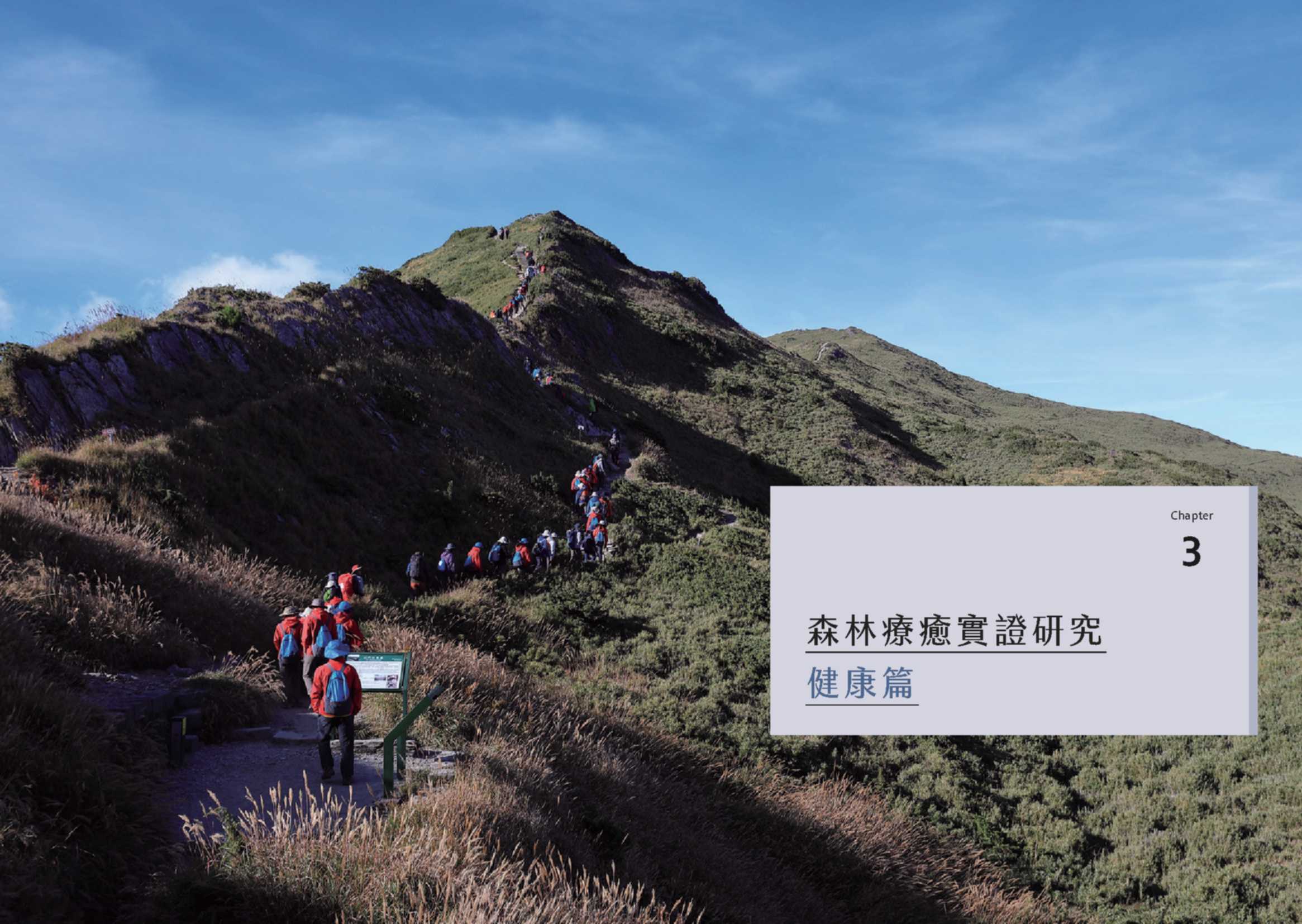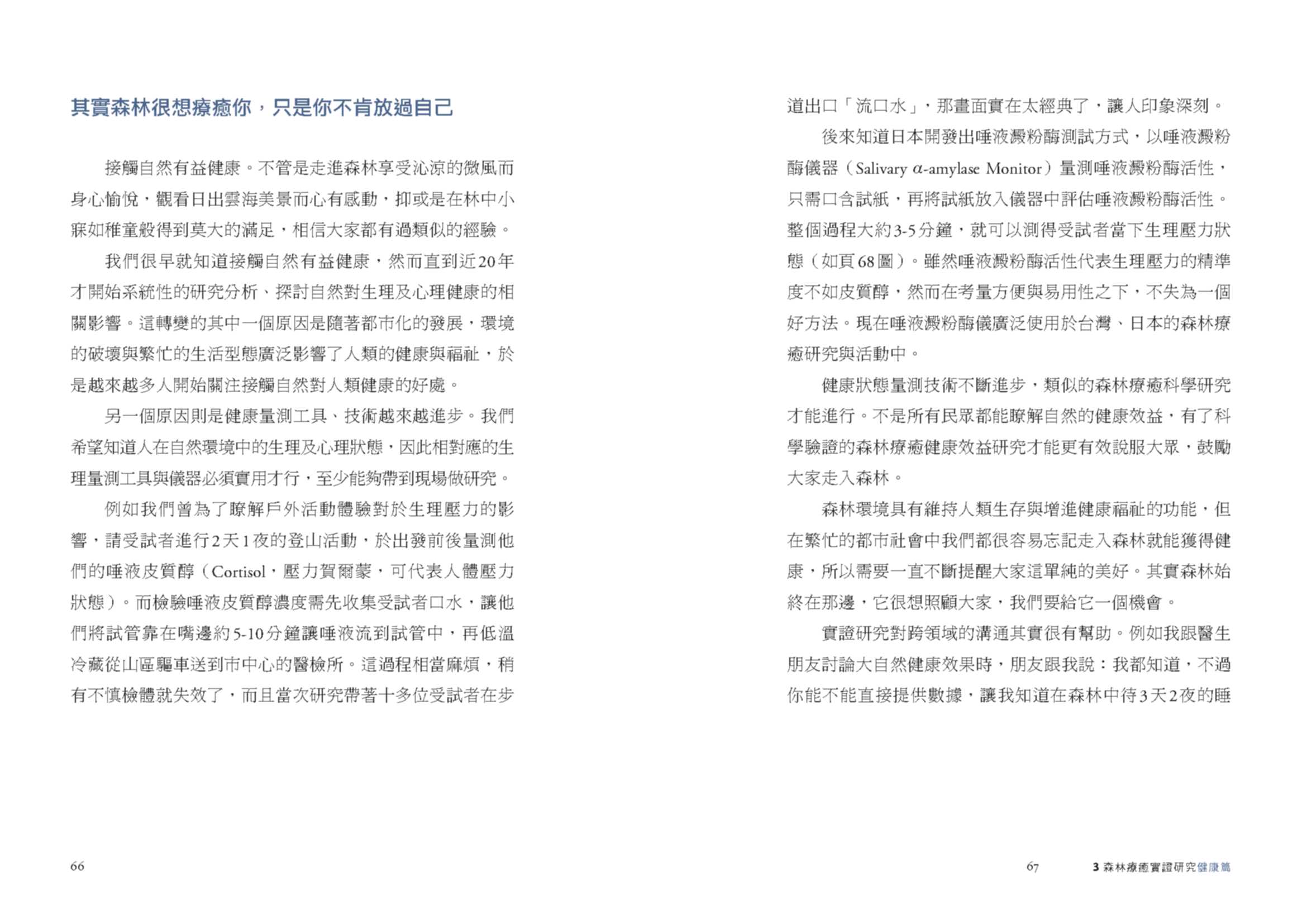
| 中文書名 | 森林療癒力
【附《一個人的森活指南》別冊】:forest, for + rest,走進森林讓身心靈休息、讓健康永續 |
| 作 者 | 余家斌 |
| 系 列 | LOHAS.樂活 |
| 出 版 | 聯經出版 |
| 出版日期 | 2022/07/28 |
| EAN | 9789570864038 |
| 書本尺寸 | 長21×寬14.8×高1.55cm / 240頁 |
| 印 刷 | 平裝 / 25開 / 彩色印刷 |
內容簡介
forest,for + rest,森林,是讓人身心靈休息、恢復的地方,
森林環境提供人類在工作繁忙之餘,一個安靜、和諧、舒適、愉快的遊憩場域。
除了就醫、吃保健食品,森林療癒也是最簡單、最無副作用的健康促進方式。
台灣自然生態豐富,公園散步、郊山健行、高山攀爬,皆有促進健康的效果,
力行森林療癒與環境一起變健康的正向循環過程,正是我們與環境的共存之道。
《森林療癒力》詳述先進國家及台灣森林療癒的源起、發展與願景,
引領讀者走入森林療癒的世界,找回平靜的身心靈。
★ 隨書附贈《一個人的森活指南》必備實用別冊!
提醒您:參與森林療癒活動時應注意事項、進行森林療癒活動前後應做健康檢測、自己可以體驗的療癒活動 
其實森林很想療癒你,只是你不肯放過自己!
● 每次進行20~30分鐘的自然體驗,可以有效減少生理壓力。
● 每週至少走入戶外綠地30分鐘,能有效減少憂鬱並降低血壓。
● 每週逛花園或公園4~5次,是降低憂鬱感的最佳方法。
● 每週至少接觸大自然120分鐘,可以提升幸福感。
人是自然的一部分,在自然中便覺生命完整。自然的芬多精、負離子、五感活動等體驗,是感動人並喜愛大自然最有效的方式。
越來越多的研究也驗證了自然環境與健康的關聯密切,因此先進國家建立都市綠帶與藍帶將自然帶入都市中,減少都市化帶來的負面衝擊,或是鼓勵民眾走出戶外,促進健康;更積極的,則將自然保健概念帶入醫療體系中,把健康促進與疾病預防的工作納入醫療體系。這些方式都能幫助大家提升生活品質、減少社會醫療支出。
2018年時,台灣65歲以上老年人口占總人口比率已超過14%,成為「高齡社會」,預計於2026年邁入老年人口占20%以上的「超高齡社會」。台灣人口結構逐漸老化,突顯了現今高齡者健康促進的重要性,所以的確需要積極參考德、日、韓等國的森林療癒進程,以推動在地的森林療癒發展。
目前,台灣林務局選定了8處國家森林遊樂區:阿里山、八仙山、太平山、奧萬大、富源、雙流、知本、東眼山作為森林療癒場域,溪頭自然教育園區早已成為大眾喜愛的森林浴景點,台灣森林保健學會則有如森林療癒的研究與推廣重鎮,都正在積極整合、推動多樣化的森林療癒活動,以維護大眾健康。
這次全球疫情大流行,有部分原因是由於人與自然環境的衝突,因為自然環境被破壞,人類與攜帶病原體的動物之間頻繁接觸所造成的。環境的健康就是人類的健康,他人的健康即是我的健康,森林療癒活動可以讓大家「防患於未然」,體驗如何健康過生活,而從大自然得到健康的我們也需要維護自然環境健康,這種正向的鮮活循環,即是「健康森林,健康人群」的健康一體概念,也是根除疫情、永續願景的實踐。
目次
- 推薦序 來看,這個說故事的人 ╱林一真
- 推薦序 在森林的擁抱裡找回自己 ╱林華慶
- 推薦序 森林療癒力無所不在 ╱袁孝維
- 自序 與自然共存
-
-
第1章 都市化帶來的健康問題
- 人類生存環境的轉變
- 都市生活帶來的健康問題
- 瞭解你的負能量,不要被杏仁核綁架
- 都市綠化解決社會治安問題
- 都市公園化,公園森林化,促進健康福祉
-
-
第2章 健康問題的解決方案—─森林療癒
- 森林不只是綠金,也維持人類生存
- 森林療癒的起源
- 什麼是森林療癒?
- 從森林浴到森林療癒
- 森林療癒,越玩越健康
- 健康一體
- 森林療癒與醫學治療
-
-
第3章 森林療癒實證研究—─健康篇
- 其實森林很想療癒你,只是你不肯放過自己
- 只要從都市走入森林就能夠有降低血壓的效果
- 走入森林還可以調節血壓
- 森林浴體驗可以提升免疫力
- 森林體驗有助於自律神經功能調節
- 森林可以改變你的腦波
- 森林療癒改善心理健康
- 窗外自然美景讓人提早出院
- 「垃圾吃、垃圾大」是金ㄟ
- 抗憂鬱疫苗存在於自然土壤中
- 想要功課好,常往自然跑
- 森林療癒提升中高齡創意能力
- 虛擬實境自然體驗在健康照護上的應用
- 接觸自然的劑量
-
-
第4章 森林療癒實證研究—─療癒環境篇
- 森林療癒環境不只是芬多精、負離子
- 森林環境對健康的影響
- 森林氣候地形療法
- 森林中五感的健康效益
- 森林視覺景觀療癒效果
- 森林觸感與聲音
- 森林空氣的療癒效果
- 森林味覺
- 森林管理有助於療癒環境建構
-
-
第5章 世界的森林療癒
-
第6章 森林療癒在台灣
- 台灣森林療癒的發展
- 森林療癒怎樣才有效?
- 森林裡的健身教練──森林療癒師
- 樂齡抗老化俱樂部──森林療癒中心
- 來一場以健康為名的社會運動──森林療癒
-
-
第7章 大家都能體驗的森林療癒
- 台灣的森林療癒活動
- 從事戶外活動要注意安全
- 自己可以體驗的森林療癒活動
-
- 參考文獻
- 【別冊】一個人的森活指南
幸福推薦
王瑞閔 金鼎獎植物科普作家
李卿 日本醫科大學附屬病院康復醫學科臨床教授
林一真 陽明交通大學兼任教授
林華慶 林務局局長
袁孝維 臺灣大學森林環資系教授、台灣森林保健學會理事長
上原巖 東京農業大學教授
溫佑君 肯園創辦人
詹長權 臺灣大學公衛學院院長
蔡明哲 臺灣大學森林環資系教授、臺灣大學實驗林處長
推薦語 當心有所惑,那就一起來感受《森林療癒力》吧!
──王瑞閔,金鼎獎植物科普作家
閲讀一本把森林療癒學術研究和你我凡常生活靈巧融合的書,是一大享受。欣賞美麗的大自然圖片,品覽富含意義的文字,好像聆聽一個又一個故事,引領我們到悠遠又熟悉的國度。
──林一真,陽明交通大學兼任教授
當你感到身心再次沒電,記得回到森林的懷抱,感受大自然不可思議的療癒力。
──林華慶,林務局局長
新冠疫情的肆虐,鎖國封城帶來的創傷,讓我們更體會到森林療癒的珍貴價值,「愈是疫情,更要療癒!」
──袁孝維,臺灣大學森林環資系教授、台灣森林保健學會理事長
帥氣的余家斌教授是國際上森林療癒研究的新星,從本書可以一窺森林療癒與人類健康在台灣以及世界上的發展。
──上原巖,東京農業大學教授
作者簡介
作者:
余家斌 國立臺灣大學森林環資系副教授
傅爾布萊特哈佛公衛訪問學者
《休閒科學》副主編(Leisure Sciences Associate Editor)
臺灣大學實驗林副處長
台灣森林保健學會秘書長
研究領域包括自然、遊憩與健康,森林療癒,保健旅遊,虛擬實境與健康照護。
林務局認證森林療癒師
林務局認證森林療癒師督導
FB粉絲團「森林療癒力」
推薦序(節錄)
在森林的擁抱裡找回自己/林華慶
森林是一個無限可能的集合體。她既提供了木材、食物、藥物、纖維等人類需要的物質,同時也讓無數生物在此繁衍生息。她吸收二氧化碳,帶來新鮮的氧氣,製造負離子與芬多精;她涵養了水源,讓風與樹、鳥與蟲、溪與石在此分分秒秒演奏著天籟;春天奼紫嫣紅,夏季的盛綠、秋天的暖紅,到冬天覆蓋一切的白,季節遞嬗中不斷變換的五感旅程,總是溫柔而無私地療癒走進其中的人們。
許多都會民眾長期累積身心壓力,造成健康失衡,在森林環境中,透過專業者引導,運用身體五感體驗自然的生命力,感受與環境合而為一,這種「慢旅行」已逐漸獲得民眾接受與喜愛。
為了促進國人身心健康、也使民眾更能分享山林帶來的惠益,林務局推動森林療癒基地建置與專業課程、體驗遊程設計,並於2021年推出森林療癒師認證培訓制度及培訓平台。目前已於阿里山、太平山、八仙山、奧萬大、富源、雙流、知本、東眼山等8處國家森林遊樂區建置森林療癒基地,除了優化設施,也結合周邊部落資源,發展各類型森林療癒活動。2019年起推動的「林業永續多元輔導方案」,也將森林療癒納入非木質的人工林產業多元發展目標,讓森林更能發揮其服務價值。且於2021年3月推出森林療癒師認證培訓制度及建置森林療癒師認證培訓平台,積極發展森林療癒活動。
余家斌老師《森林療癒力:forest, for+rest,走進森林讓身心靈休息、讓健康永續》全面探討森林療癒的國內外發展脈絡,從都市化帶來的健康問題及其解決方案,到國外案例及相關實證說明,帶領大家認識世界的森林療癒發展,例如日本森林療癒步道的巧思設計,以及森林療癒基地的美學概念;在德國,民眾則可
透過健康保險補助森林療養相關費用,促進健康旅遊產業發展;韓國有山林治癒園,提供一系列醫療設備給森林療癒效益實證研究使用,並規劃住宿、餐飲和多樣化的療癒活動,建置森林福祉服務體系,這些都值得台灣借鏡。
誠如余老師書中所言:「森林是讓人身心靈休息、恢復的地方。」當你感到身心再次沒電,記得回到森林的懷抱,感受大自然不可思議的療癒力。…
內文連載


■ 第3章 森林療癒實證研究──健康篇
其實森林很想療癒你,只是你不肯放過自己
接觸自然有益健康。不管是走進森林享受沁涼的微風而身心愉悅,觀看日出雲海美景而心有感動,抑或是在林中小寐如稚童般得到莫大的滿足,相信大家都有過類似的經驗。
我們很早就知道接觸自然有益健康,然而直到近20年才開始系統性的研究分析、探討自然對生理及心理健康的相關影響。這轉變的其中一個原因是隨著都市化的發展,環境的破壞與繁忙的生活型態廣泛影響了人類的健康與福祉,於是越來越多人開始關注接觸自然對人類健康的好處。
另一個原因則是健康量測工具、技術越來越進步。我們希望知道人在自然環境中的生理及心理狀態,因此相對應的生理量測工具與儀器必須實用才行,至少能夠帶到現場做研究。
例如我們曾為了瞭解戶外活動體驗對於生理壓力的影響,請受試者進行2 天1夜的登山活動,於出發前後量測他們的唾液皮質醇(Cortisol,壓力賀爾蒙,可代表人體壓力狀態)。而檢驗唾液皮質醇濃度需先收集受試者口水,讓他們將試管靠在嘴邊約5-10分鐘讓唾液流到試管中,再低溫冷藏從山區驅車送到市中心的醫檢所。這過程相當麻煩,稍有不慎檢體就失效了,而且當次研究帶著十多位受試者在步道出口「流口水」,那畫面實在太經典了,讓人印象深刻。
...
■ 第5章 世界的森林療癒
韓國山林治癒園
韓國和台灣一樣擁有豐富的森林資源,森林約占全國面積63%,傳統上即有採集草藥、冥想、森林浴等利用森林促進健康的習慣。韓國政府於90年代開始設立自然療養林,之後推動「促進人類健康的森林」(Forest for Health)計畫,希望透過森林場域提升人類健康及福祉。同時整合山林治癒體驗、研究與教育,希望將山林治癒事業產業化。
為了建立促進健康的森林示範點,韓國政府從制定法案開始,2007年通過國立山林治癒園法案,成為總統公約產業,是促進經濟發展先導計畫之一;2012年完成山林治癒園基本建設與設計;2015年通過《森林福利促進法》,將森林福祉(Forest Welfare)視為國民重要社會福利之一。
韓國政府將推廣的軟硬體活動依照年齡區分為7個階段,分別為︰ G1出—胎教林、G2幼兒期—森林幼稚園、G3青少年期—森林教育、G4青年期—森林休閒運動、G5中年期—健康休閒林、G6老年期—森林療癒、G7過世—樹葬林,又稱為「綠色福利7」,並透過森林幼兒園、森林露營區與森林療癒基地各類不同的場域,滿足不同年紀國民親近自然的需求,提升國民的森林福祉。
2016年,韓國成立「韓國森林福祉中心」(Korea Forest Welfare Institute, FoWI),推動森林福祉相關政策及研究、輔導認證自然療養地、培訓相關人才,以打造更完善的體系,為民眾提供多樣化且系統化的森林福祉服務。其中硬體部分細分為森林遊樂區、森林公園、療癒森林、森林幼稚園、森林教育中心及其他相關研究設施;軟體部分則提供更細緻的人員分工,包含森林教育解說員、幼童森林指導員、森林步道指導員,以及森林療癒指導員。
森林福祉中心經費主要由韓國樂透盈餘所支付,其下各山林治癒園與相關機構雖然仍無法自給自足,但仍給予低收入家庭及身心障礙族群每年10萬韓元的補助,提供他們接觸、利用森林保健最基本的資源。
韓國國家山林治癒園位於榮州市近郊,為韓國森林療癒主要示範點,中心內設置療癒研究中心,有醫療設備提供森林療癒效益實證研究使用,規劃有完善的住宿、餐飲,並提供多樣化的療癒活動,包含森林五感療法、健康徒步療法、北歐式健走等戶外活動,以及保健藥草茶包、植物香氛蠟燭、香氛精油等各式芳香療法的製作課程。
療癒中心設有水療區,可以治療關節、強化腰部、恢復疲勞、紓緩緊張,以及活化五感、刺激足部的各式療癒庭園;室內有完整的健身和放鬆器材,如飛輪、跑步機、按摩水床、紅外線氣血循環機、音樂放鬆躺椅。課程則有針對不同族群的套裝行程,如青少年身心健康戶外課程,或是針對孕婦所提供的森林胎教課程。
...
■ 第6章 森林療癒在台灣
台灣森林療癒的發展
台灣森林療癒的發展可以追溯到1983年,林文鎮博士引進日本「森林浴」的觀念,並撰寫《森林浴的世界》、《森林美學》與《森林保健論》等書,大力推廣森林保健。1989年,呂錦明博士翻譯日本學者岩崎輝雄所著《森林的健康學》一書,開始將此觀念在國內扎根。
2010 至2012年,林務局羅東林管處委託馬偕醫學院與中興大學森林系林一真、申永順、廖天賜三位教授,進行「森林治療評估準則之建立與示範推動工作之研析與規劃」計畫,以太平山森林遊樂區為研究地點,針對健康指標、環境規劃、方案設計及評估效益進行研究,是國內森林療癒研究的濫觴。
2013年,臺大森林系袁孝維、蔡明哲兩位教授與余家斌副教授開始台灣森林療癒活動的推廣與研究。2016年,「台灣森林保健學會」成立,在林務局指導下,系統性地在各地推動相關活動,森林療癒成為台灣林業發展重要的新方向。
2017年,森林保健學會開始協助執行「林務局森林療癒之發展策略暨行動計畫」,規劃林務局的森林療癒推展方針與策略,並召開專家會議擬定國家森林遊樂區療癒場域選址原則。參考德國及日本森林療養地及療癒步道的指標後,決定5項評估指標:1.五感良好的自然環境,2.環境設施的整備狀況,3.區位條件,4.管理現況,5.森林療癒活動。最後在18處國家森林遊樂區選中8處作為重點發展區域:太平山、東眼山、八仙山、奧萬大、阿里山、雙流、知本、富源。
2018年,森林保健學會協助推動「林務局國家森林遊樂區森林療癒健康促進推廣計畫」,將森林療癒活動導入各森林遊樂區,並且辦理「森林療癒師」認證制度。不論是一般民眾或身心障礙人士皆可在森林遊樂區體驗森林療癒活動,例如,八仙山森林療癒活動即曾推廣至視障團體,帶領視障朋友走入山林體驗自然。
臺灣大學實驗林為中部發展森林療癒的重要場域,其中「溪頭自然教育園區」尤具代表性。溪頭海拔1,100-1,700公尺,年平均溫度約18°C,涼爽宜人,是名副其實的避暑勝地,每年遊客約200萬人。園區內擁有豐富的自然資源,包括柳杉、台灣杉、紅檜、銀杏、扁柏等珍貴樹種,加上完善的步道系統,讓此地成為國內森林療癒體驗的絕佳場所。
...
■ 第7章 大家都能體驗的森林療癒
台灣的森林療癒活動
林務局選定阿里山、八仙山、太平山、奧萬大、富源、雙流、知本、東眼山8處國家森林遊樂區作為森林療癒場域,並委託台灣森林保健學會推動森林療癒訓練與課程活動。中台灣溪頭教育園區是廣為國人喜愛的森林遊樂區,目前也積極推動森林療癒活動,除了多樣化的森林療癒活動,每月一次的「森林療癒講堂」,上午進行健康講座,下午則帶領民眾體驗療癒活動,協助中部地區的樂齡長者保持健康與活力。另外,臺大森林系自然資源遊憩研究室也在台北的臺灣科教館舉辦一系列森林療癒活動,作為森林療癒在都市區的研究與推廣。
由於各地森林資源不盡相同,發展出來的森林療癒活動也相當多元。以溪頭的森林療癒活動為例,在一天的行程中,會先安排心跳與血壓的簡單健康檢測,瞭解學員的身體狀況是否適合進行一整天的戶外活動,再用唾液壓力試片評
估活動前的壓力狀態,之後在林間進行約莫20分鐘的腹式呼吸練習與暖身操,讓大家適應森林裡的溫度,緩緩做好出發前的準備。
接下來就是溪頭森林療癒步道中的五感體驗,打開身心靈體驗溪頭柳杉林一草一木的美好。透過尋找樹上的果實,擁抱與撫摸大樹觸感,聆聽溪流與林間蟲鳴鳥叫,嗅聞搓揉後的柳杉葉,以及使用剛才練習過的呼吸法,深刻感受林間豐富的樹木花草氣味,這樣的自然體驗能協助大家沉浸於自然當中,忘卻平日的煩惱。
接著邀請學員於竹廬旁的草地脫下鞋子,赤腳享受與大自然親密的接觸,恢復體內平衡。在林間木平台上,由專業的瑜伽老師帶領進行瑜伽伸展活動,補充滿滿的元氣。之後在小木屋中,將步道健行時採集的植物,以拓染的方式貼在環保袋,做成綠色伴手禮帶回家。
行程結束前再做一次健康檢測,瞭解自己經過一天療癒活動後健康改善的程度。這樣的過程饒富趣味,感受到自然的饋禮,也療癒了身心。
林務局委託台灣森林保健學會在各森林遊樂區舉辦的森林療癒活動也相當有趣,可以在草地上或是林間進行北歐式健走,訓練肌耐力與心肺功能,在優美的自然環境中進行健走活動一點都不覺得疲累。炎炎夏日中也可脫掉鞋襪漫步在溪水中,享受水與圓石的按摩,放鬆緊繃的肌肉。體力較好的學員,可在攀樹師的指導下學習拋繩、打繩結,攀爬至樹冠層,挑戰自己的體能,在樹梢間從不同的角度欣賞大地之美,讓人心曠神怡。
想要安靜一下也無妨,可以進行自然寫生、森林冥想、孤獨體驗或是參與夜間觀星活動,透過與自然連結慢慢地沉澱自己。此外,也邀請原民社區講師分享當地飲食文化,親手製作在地特色料理,透過美食品嚐與當地文化連結,可對在地文化有更深的瞭解。
有鑒於台灣高齡化的趨勢,以及思考到都市人是最需要森林療癒的族群,因此臺大森林系自然資源遊憩研究室從「森林療癒從都市開始」的概念出發,以北部地區樂齡族群為對象,使用臺灣科教館屋頂花園及鄰近都市林地與郊山場域推動一系列森林療癒活動。
活動內容包含自然集體創作、植物拓染、河濱步道北歐式健走、芝山岩自然五感體驗等,讓長輩們在專業課程的帶領下,透過自然體驗達到身心平衡;並邀請郭建中醫師帶領竹杖健走活動,對抗好發於樂齡長者的肌少症,幫長輩把肌肉玩回來。
這些森林療癒活動都有講師引導,在經營管理完善的森林自然環境進行,這些活動可以確保學員在戶外的安全,安心地細細品味自然、與自然結合,並且療癒身心,保健身體。
...
...

 其實森林很想療癒你,只是你不肯放過自己!
其實森林很想療癒你,只是你不肯放過自己!







